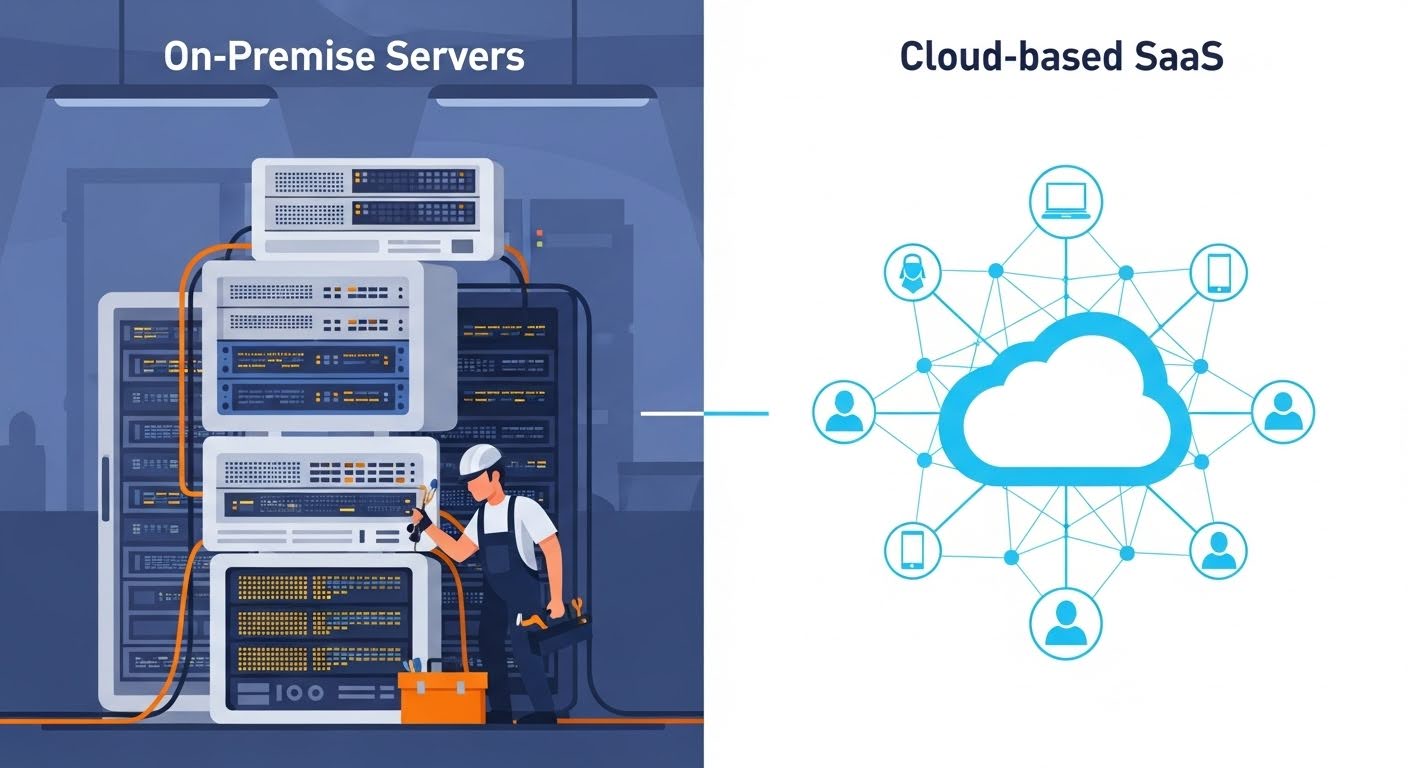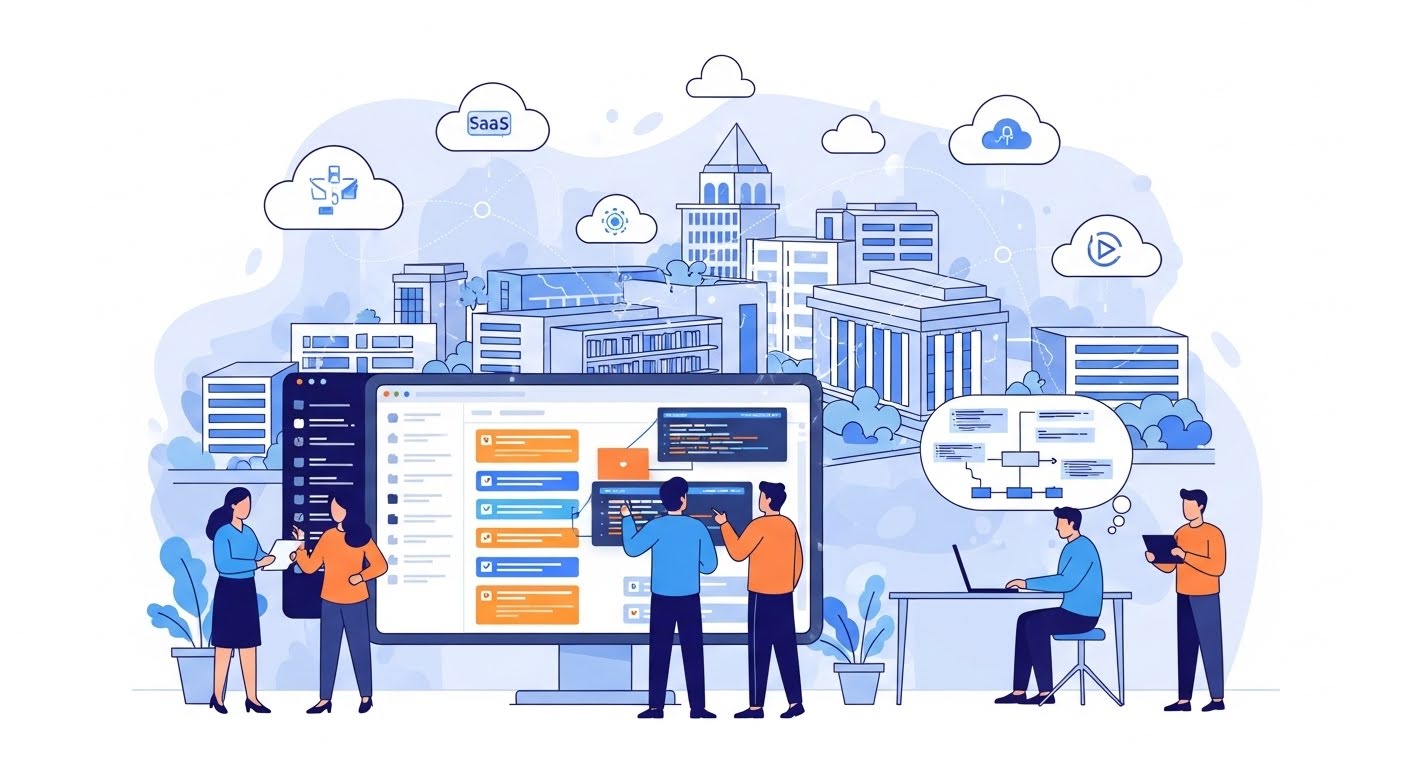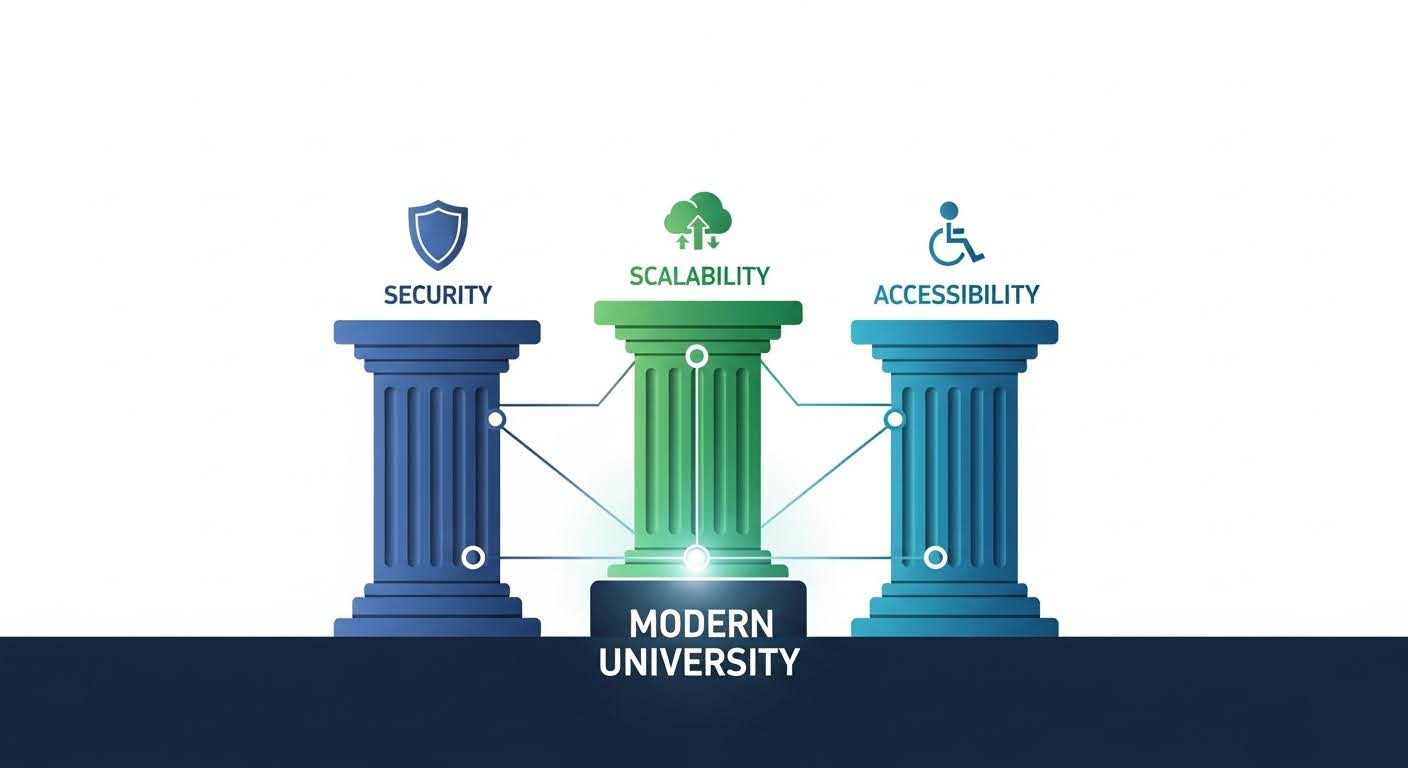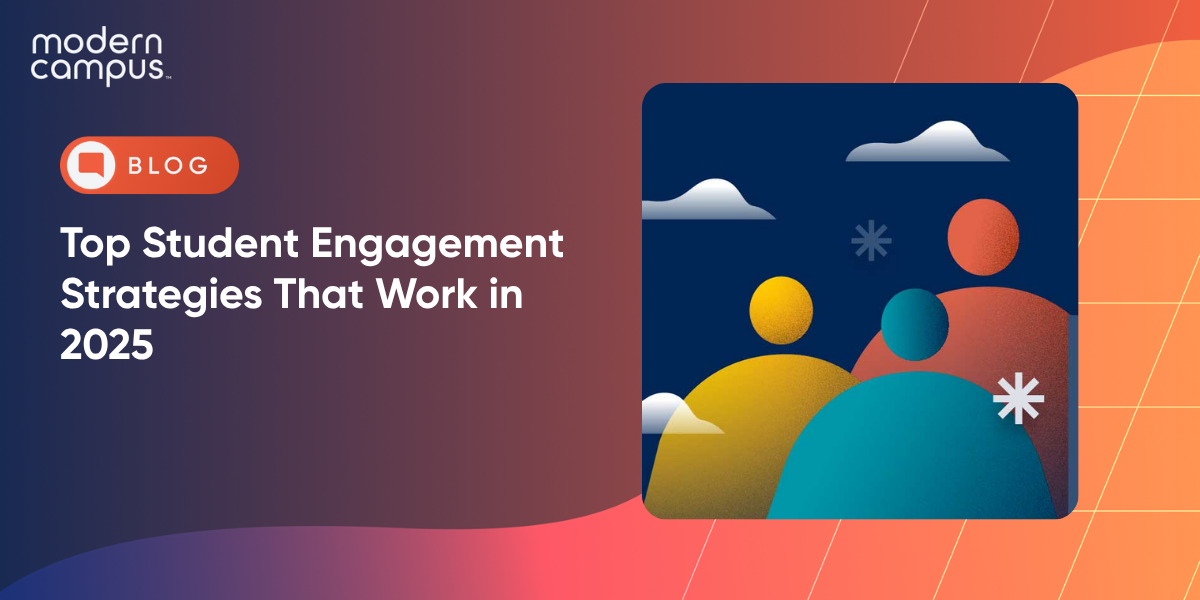Why SaaS Content Management Systems Are the Future of Higher Ed
Institutions are adopting SaaS (software as a service) content management systems to reduce costs, improve security and accelerate digital transformation.
- Cost efficiency: SaaS eliminates expensive on-premise infrastructure and reduces IT maintenance.
- Enhanced security: Purpose-built platforms offer automatic updates and compliance features that protect student data.
- Scalability: Cloud-based systems handle traffic spikes during enrollment periods without additional hardware investments.
- Future-ready: SaaS enables institutions to adapt quickly to changing student expectations and regulatory requirements.
Universities that embrace SaaS CMS technology position themselves to deliver modern digital experiences while optimizing operational efficiency.
Higher education is constantly facing new and fluctuating challenges. Undergraduate enrollment dropped 15% between 2010 and 2021, and analysts predict a further 15% decline in 18-year-old high school graduates by 2039. Between half and three-quarters of private and public institutions face budget shortfalls. Meanwhile, students arrive on campus expecting digital experiences that rival ecommerce and entertainment platforms: seamless, personalized and always available.
This shift is forcing institutions to rethink their technology. The era of maintaining expensive on-premise servers and wrestling with legacy content management is ending. Instead, forward-thinking universities are embracing SaaS content management systems that deliver the agility, security and scalability higher education demands.
What Is a SaaS Content Management System?
A SaaS content management system operates entirely in the cloud, delivering website functionality through internet-based services rather than local servers. Unlike traditional on-premise solutions that require universities to purchase, install and maintain hardware and software on campus, SaaS platforms are hosted and managed by specialized providers.
With on-premise systems, your institution owns the entire infrastructure—including servers, software licenses, maintenance contracts, security updates—and the IT staff to manage it all. Meanwhile, SaaS systems provide a fully-managed service that handles technical complexity so you can focus on creating compelling digital experiences for students.

Universities need content management systems that can handle everything from admissions marketing and course catalogs to alumni engagement and emergency communications. A cloud CMS for institutions delivers these capabilities without the operational overhead that strains already-stretched IT budgets.
How Does SaaS Compare to Traditional On-Premise CMS Solutions?
The differences between SaaS and on-premise content management extend beyond hosting arrangements. Each option holds a fundamentally different philosophy about technology ownership, risk management and resource allocation.
Implementation and Maintenance
On-premise CMS: Often requires extensive planning, hardware setup, software installation and configuration. Universities must coordinate across multiple vendors, manage integrations and train IT staff on new systems. Once deployed, these platforms demand continual maintenance (security patches, software updates, hardware replacements and performance monitoring), all of which consume significant time and resources.
SaaS CMS: Streamlines this entire process. With a cloud CMS for universities, the provider handles:
- Infrastructure setup
- Ongoing maintenance
- System updates
Institutions can focus on creating and managing content rather than troubleshooting servers or coordinating software upgrades. This hands-off approach accelerates deployment, simplifies operations and ensures universities always run the latest, most secure version without manual intervention, one of the clearest advantages in the SaaS vs. on-premise CMS debate.
Cost Structure and Predictability
On-premise CMS: Requires substantial upfront capital investments. Universities must purchase server hardware, software licenses, storage systems and networking equipment before seeing any value. These costs often strain institutional budgets and are followed by additional expenses for ongoing maintenance, energy usage and IT staffing.
SaaS CMS: Operates on a predictable subscription model that transforms unpredictable capital expenditures into manageable operating costs. With a cloud CMS, institutions pay recurring fees that include:
- Hosting
- Maintenance
- Security updates
- Customer support
This structure provides clearer budget visibility and eliminates unexpected hardware or repair costs that can disrupt financial planning.
For higher ed content management teams, this predictability also supports long-term strategy. Administrators can plan technology investments with confidence, freeing resources to focus on academic innovation and student experience improvements, further highlighting the value of SaaS vs. on-premise CMS solutions.
Security and Compliance
On-premise CMS: University IT teams face increasing pressure to protect sensitive student data while maintaining compliance with regulations like FERPA and state privacy laws. Traditional systems place the entire security burden on institutional resources, from firewall management and intrusion detection to data backup and disaster recovery.
SaaS CMS: Leading SaaS providers invest millions in security infrastructure that individual universities couldn't afford independently. These platforms offer compliance frameworks specifically designed for higher ed content management:
- Enterprise-grade encryption
- Automated backup systems
- 24/7 security monitoring
The shared responsibility ensures both provider and institution contribute to comprehensive data protection.
Why Are Higher Education Institutions Evaluating SaaS Solutions Now?
Several trends are accelerating higher ed's migration toward cloud-based content management systems. These technological shifts fundamentally change how universities operate and compete for students.

Financial Pressures and Resource Optimization
Budget constraints continue to challenge nearly every institution. Overall state appropriations for higher education grew modestly in the 2025 fiscal year, but once inflation was accounted for, funding actually declined in nearly one-third of states. Many institutions are also facing reduced stimulus support and ongoing enrollment uncertainty, which places additional pressure on already-tight budgets.
A SaaS content management system helps universities address these financial realities by eliminating costly hardware investments and reducing IT maintenance demands. A cloud CMS for universities allows you to reallocate limited resources toward student-focused initiatives, academic innovation and digital engagement.
Rising Student Expectations
Most students grew up with smartphones and expect institutional technology to match consumer-grade experiences. They demand fast-loading websites, mobile-responsive design and personalized content that helps them navigate academic offerings. Students increasingly remove schools from consideration if their websites are difficult to use.
SaaS platforms enable universities to deliver these modern experiences without extensive custom development. Built-in personalization tools, mobile optimization and user experience features help institutions meet student expectations while effectively competing for enrollment.
Cybersecurity Threats and Compliance Requirements
Cybersecurity has become one of the most urgent challenges facing higher education. Universities store vast amounts of sensitive data—like student records, financial details and research information—making them frequent targets for cyberattacks.
Legacy systems and outdated infrastructure heighten these risks, often overwhelming university IT teams that must balance daily operations with complex security management. A SaaS content management system provides enterprise-grade protection managed by specialists.
Leading cloud CMS delivers continuous security monitoring, automatic updates and compliance frameworks specifically designed for higher education. Features like data encryption, secure authentication and regular third-party audits help institutions maintain compliance with regulations. This proactive, built-in security allows higher ed content management teams to focus on innovation and student experience rather than constant threat response, demonstrating another key advantage of SaaS vs on-premise CMS platforms.
Acceleration of Digital Transformation
The COVID-19 pandemic accelerated digital adoption across higher education, forcing institutions to rapidly deploy online services and virtual engagement tools. This experience highlighted the limitations of legacy on-premise systems that couldn't scale quickly or adapt to changing requirements.
88% of institutions have moved more than a quarter of their applications into the cloud, with 56% reporting increased agility and efficiency from cloud adoption.
5 Key Benefits of SaaS Content Management for Universities
Modern institutions are rethinking how they manage digital experiences, seeking solutions that simplify operations while enhancing student engagement. These five benefits illustrate how a SaaS CMS empowers universities to operate more efficiently and deliver exceptional online experiences.

1. Dramatic Cost Reduction and Budget Predictability
SaaS content management systems restructure institutional technology economics. Instead of large upfront capital investments that stress budgets, universities pay predictable monthly or annual subscription fees that include hosting, maintenance and support.
Cloud adoption eliminates numerous hidden costs associated with on-premise systems. Universities no longer need to budget for:
- Server hardware replacement
- Software license renewals
- Utility costs for data center cooling
- Specialized IT staff to manage infrastructure
The predictable cost structure also enables better planning. Administrators can accurately forecast technology expenses years in advance, making it easier to allocate resources toward academic programs and student services that directly impact your institutional mission.
2. Enterprise-Grade Security Without Enterprise Complexity
SaaS providers invest heavily in security infrastructure that individual universities can't replicate. These platforms offer multi-layered protection, including:
- Encrypted data transmission
- Automated backup systems
- Intrusion detection
- 24/7 security monitoring by specialized teams
Purpose-built higher education SaaS platforms include automatic security updates, HTTPS validation for all URLs and compliance frameworks designed for higher education. This comprehensive approach reduces security risks while freeing university IT teams to focus on strategic initiatives rather than constant threat management.
3. Effortless Scalability During Critical Periods
University websites experience dramatic traffic variations throughout the academic year. Enrollment periods, application deadlines and emergency communications can increase website traffic within hours. On-premise systems often struggle with these spikes, leading to slow loading times or complete outages during critical moments.
Cloud-based content management systems automatically scale computing resources to match demand. When thousands of prospective students visit during application periods, the platform seamlessly allocates additional server capacity. When traffic returns to normal levels, resources scale back down, ensuring universities only pay for what they use.
This elasticity extends beyond website traffic. Universities can rapidly deploy new microsites for special programs, expand storage for digital assets or add user accounts for new departments without lengthy procurement processes or hardware installations.
4. Accelerated Innovation and Feature Development
On-premise content management systems typically receive major updates once or twice yearly, often requiring complex installation processes and extensive testing. This slow upgrade cycle means universities lag behind current web standards and miss opportunities to implement new engagement tools.
SaaS platforms deliver continuous innovation through automatic updates that add new features without disrupting operations. Universities seamlessly gain access to the latest:
- Accessibility tools
- Personalization capabilities
- Mobile optimization features
- Integration options
This rapid innovation cycle enables universities to experiment with new digital engagement strategies, respond quickly to changing student preferences and maintain competitive advantages in student recruitment and retention.
5. Simplified Integration and Ecosystem Connectivity
Institutions operate complex technology ecosystems, including:
- Student information systems
- Learning management platforms
- CRM tools
- Financial systems
On-premise content management systems often struggle with these integrations, requiring custom development work and ongoing maintenance.
Purpose-built SaaS platforms for higher education include pre-built integrations with leading university systems. These connections enable dynamic content updates and personalized student experiences without complex custom coding.
These integrations extend to marketing and communication tools as well. Universities can connect their content management system with email marketing platforms, social media management tools and analytics systems to create comprehensive digital engagement strategies.
Security and Scalability: The Foundation of Modern University Operations
Reliable performance and built-in protection are essential to maintaining trust and continuity across every digital touchpoint. Security and scalability form the backbone of modern university operations, ensuring that institutional websites, systems and data remain accessible, compliant and resilient even during peak demand.

Accessibility and Compliance Integration
Web accessibility compliance is a legal requirement and moral imperative for universities. The U.S. Department of Education's Office for Civil Rights actively investigates institutions with inaccessible websites, potentially resulting in costly legal action and reputational damage.
SaaS content management systems designed for higher education include built-in accessibility tools that help universities automatically maintain WCAG 2.1 compliance. These platforms scan content for accessibility issues, suggest corrections and ensure new pages meet standards before publication.
Purpose-built platforms include accessibility check features that continuously monitor university websites for compliance issues, providing detailed reports and remediation guidance. This proactive approach helps institutions avoid OCR investigations while ensuring equal access for all students and community members.
Performance and Reliability at Scale
University websites can't afford downtime during critical periods like enrollment, emergency communications or major campus events. SaaS platforms offer uptime guarantees that typically exceed 99.9%, backed by redundant infrastructure and professional monitoring.
Content delivery networks ensure fast loading times regardless of user location, while automated caching systems optimize performance during traffic spikes. These technical capabilities enable universities to maintain professional digital experiences even during periods of intense demand.
The scalability extends to content management workflows as well. Institutions can support hundreds of content contributors across multiple departments without performance degradation, enabling decentralized content creation while maintaining centralized oversight and brand consistency.
FAQ
Q: What happens to our data if we decide to change SaaS CMS providers?
A: Reputable SaaS providers offer data portability guarantees and export tools that ensure universities retain ownership of their content. Leading platforms provide comprehensive content export capabilities and migration assistance if institutions choose to transition to different providers.
Q: Can SaaS content management systems handle our complex university requirements?
A: Purpose-built higher education SaaS platforms are specifically designed to meet university needs, including academic catalogs, program management, student portal integration and compliance requirements. These systems often handle complex requirements more effectively than generic platforms.
Q: How does SaaS pricing compare to on-premise total cost of ownership?
A: While SaaS involves ongoing subscription costs, total cost of ownership typically runs lower than on-premise systems when factoring in hardware, maintenance, utilities and IT staffing costs. SaaS also provides better budget predictability.
Q: What level of customization is possible with SaaS platforms?
A: Modern SaaS content management systems offer extensive customization options through configuration rather than custom coding. Universities can create unique designs, implement specific workflows and integrate with existing systems while maintaining platform supportability.
Positioning Your Institution for Digital Success
The future of higher education belongs to institutions that can adapt quickly to changing student expectations, regulatory requirements and competitive pressures. SaaS content management systems provide the foundation for this agility, enabling universities to focus on their core educational mission while leveraging enterprise-grade technology.
Modern Campus empowers over 1,700 higher education institutions to deliver exceptional student experiences while reducing operational complexity. Schedule a demo to see how SaaS content management can position your university for sustainable success.
Last updated: November 14, 2025



